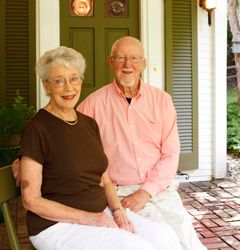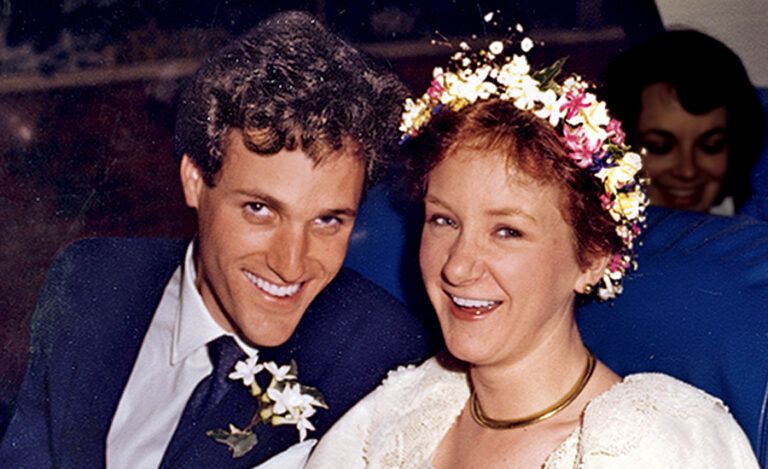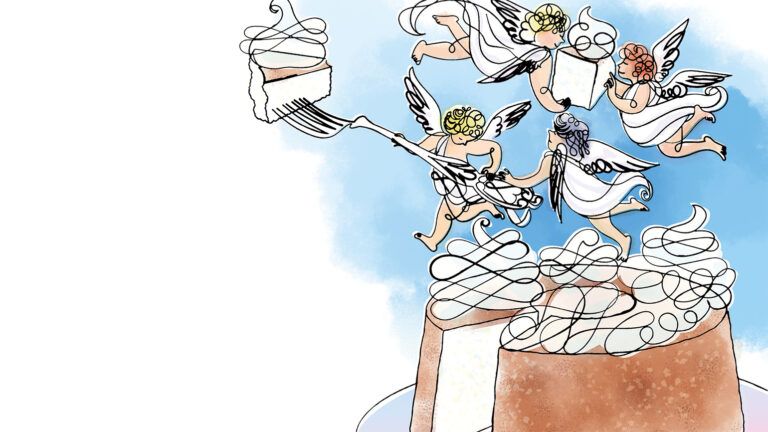Forty-one years is a long time, I thought as I waited in the motel lobby for the nun who was coming to pick me up.
I’d last come here to Belmont, North Carolina, back in 1965 to report for Guideposts on Holy Angels, a home for infants born with multiple handicaps. Though readers had been asking for an update ever since, I kept putting off a return.
I knew why. For months after that first visit I’d been haunted by the memory of those tiny innocent little people, born so injured—did I really want to put myself through that again?
There were good memories too, of course…the kindly nuns in their stiff wimples and long black habits, bending so tenderly over each crib. Most of all, a bright-eyed nine-year-old girl whose ruffled blue dress hid the arms of her small wheelchair.
Maria, born with mere vestiges of legs, a hydrocephalic with a tumor on her back as large as her oversize head, was the first handicapped baby the sisters had taken in. They were running a day nursery for children of mill workers when the local hospital asked them to take an infant just born there. A “vegetable,” hospital doctors told them, who couldn’t live more than a few weeks.
But Maria did live, and by age two, hints of an alert and eager mind appeared. The sisters took her to a surgeon: Within two years, both the tumor and her head had shrunk dramatically and Maria’s bright chatter was the nuns’ delight. The little girl’s great dream was to wear shoes. So the surgeon shaped a place on the unformed legs for shoes to go. The very first thing nine-year-old Maria had said to me was, “Do you like my shoes?” (I did indeed!)
Meanwhile, seeing Maria as God’s call to a new kind of ministry, the sisters had taken in scores of other handicapped infants. Over the years since my 1965 visit, I’d kept in touch with an occasional phone call.
Because of her precarious health, I always hesitated to ask about Maria. But each time I was told that she was not only alive, but the can-do spirit behind all they did at Holy Angels. Now that little girl was 50 years old, and I couldn’t turn down the invitation to come see what had grown from those early beginnings.
A brown SUV pulled up to the motel entrance, but instead of a nun at the wheel it was a woman in a bright red pantsuit. She came into the lobby and looked around.
“Elizabeth? I’m Sister Nancy.”
In the decades since I’d been here, the nuns’ severe black habits had obviously been exchanged for up-to-date outfits! Another change was the greatly enlarged facility that came into view as Sister Nancy followed the winding drive up the hillside.
Welcoming one-story brick-and-wood buildings connected with walkways were set in manicured lawns amid colorful gardens. In the central building, an attractive woman wearing a wide-collared cream-and-pepper sweater and a mass of auburn curls was handling calls at a reception desk.
Putting the phone down, she whipped her electric wheelchair around the desk and held out her hand. “So you finally came back! I’m Maria.”
The same smile, the same impish brown eyes. When I complimented Maria on her hair, Sister Nancy laughed. “It’s her natural color too, for a miracle! She’s had black hair, red hair, yellow hair—I’ve waited years to see the real thing.”
Leaving a replacement at the desk, Maria led me on a tour, Sister Nancy and I trotting to keep up with her chair. We started in the well-equipped medical wing. In a tile-floored room we watched a motorized sling lift a woman gently onto a cushioned bath table. The biggest surprise to me was finding adults here in place of infants: Most of the residents I saw ranged from pre-teens to mid-sixties.
“We don’t get many babies nowadays,” Sister Nancy confirmed, “and for a wonderful reason!” Parents today, she said, try to keep even the most severely handicapped children with them as long as they can. “Till they’re too heavy to lift, or too ill to care for at home.”
And when a child does come to Holy Angels, parents remain close. In the greenhouse I met Kim, a profoundly retarded woman in her 20s who responds to green, growing things. “Kim came to us when she was 11,” Sister Nancy told me, “and her mother still comes to see her every day.”
Death is common among the medically fragile people here. In one corridor photographs lined a wall. “They’re all singing with God now,” Maria said. “We call them our ‘Choir of Angels,'” She pointed to the snapshot of a little girl in a yellow sun suit. “She’s the newest angel in the choir.”
The tour continued: sunny bedrooms, a patio, an outdoor jacuzzi. Everywhere were bright colors, spinning pinwheels, scented plants, the sounds of bells, chimes, splashing water. “To stimulate all the senses,” Sister Nancy said.
And yet…despite the cheerful settings, despite the loving care so in evidence, I was wishing that I hadn’t come. I found the scenes confronting me as overwhelming as on my first visit. In a large room decorated with sunny beach scenes, amid oxygen tanks and feeding tubes, residents were propped semi-upright on slanting boards or strapped into wheelchairs, heads between padded bumpers.
And with each one, a caregiver—mostly volunteers—tending, supporting, murmuring encouragement. And clearly delighting in what they did. How was it possible! Where I was heartsick at what I was seeing, everyone I met who worked here quite simply radiated joy!
All day I wrestled with these two contradictory realities. The cruelly limited lives all around us; the buoyant spirits of those who cared for them. To go with Maria through these buildings was to join a continual celebration. I’d never seen so much hugging!
Every employee, volunteer or visiting relative we encountered had to stoop down to embrace her and exclaim over her sporty new sweater. Hugs and laughter side by side with insurmountable problems. How could someone be joyful, working day after day with a 15-year-old who was never going to speak, a 50-year-old who couldn’t hold a spoon.
True, not all those who live at Holy Angels are so limited, and visits with them were a delight. Those able to do chores like cleaning their rooms live with a staff member in separate small “group homes.” Maria proudly showed me through hers, pointing out the TV in each bedroom, the new furniture in the blue-and-white living room, the made-to-order bathrooms, hers fitted with a contraption to lift her in and out of the tub.
What she really wanted me to see, though, was her red Corvette, parked at the curb. “No, really!” she said when I expressed disbelief. “I told everyone that’s what I wanted for my 50th birthday.” And so a local company had designed a hand-controlled golf cart with a wheelchair ramp, painted it red and glued a genuine Corvette sticker to the side. “We all get out of the way when she’s driving,” Sister Nancy said. “She’s big on the accelerator but not the brakes.”
Good-natured ribbing is part of the fun at this happy place. And still I could not reconcile the upbeat mood with the terrible sadness I felt at these lives so compromised from the day of birth. My question remained: Where did this all-pervading joy come from?
Part of the secret surely was Maria herself. “No one’s ever heard her complain,” Holy Angels’ President, Regina Moody, told me. “After her double mastectomy last year she was back here at the reception desk long before the hospital wanted to let her go.”
“It was boring there,” Maria said.
But Maria’s story was the exception, the “hopeless” case who fooled the doctors. What about all these whose conditions were not going to change? We were back in the room with the beach scenes, hearing details of the day from the attendants.
“Good for you, Paul!” Sister Nancy said to a teenager slumped in a wheelchair. “I understand you stayed on the prone-stander 15 whole minutes!”
“Helen!” to a woman drooped over her tray table, “they say you were awake for a while this afternoon!”
Listening, I thought I grasped a piece of the puzzle. All day I’d been seeing palsied limbs, vacant eyes—handicaps. Maria and Sister Nancy and Regina Moody looked at the same things and saw Paul… Helen… Jack… Frances. To the staff, I suddenly understood, there were no “conditions” here, only unique and precious individuals.
But individuals with such cruel limitations! “Many will never sit up on their own,” I said to Sister Nancy. “Never talk or walk. Don’t you ever get discouraged?”
“I would if I projected myself into the future like that.” We were sitting in Sister Nancy’s office. “Here we look for what God’s doing right now, in each life this very day. That’s where God is for all of us, you know—not in the goal but in the passing moments of the journey. Here we celebrate the little victories.”
Little victories…One day Martha’s eyes might follow a finger moving left to right! Or Henry, who’s been pushing the scoop through his food with an assistant’s hand on his, suddenly pushes the scoop himself! He can’t lift it to his mouth yet. Maybe never. But something wonderful is right before our eyes.
“One mother had a single dream,” Sister Nancy recalled. “She wanted to hold her baby.” Her infant boy, however, went into convulsions whenever he was touched. Slowly, over many months, a sister trained in infant massage built up in the little body a tolerance for touch. “Stevie lived to be four years old. If you could have seen the joy in his mother’s eyes as she rocked him, you’d know why this is a happy place.”
A baby who could be held. A hand maneuvering a scoop. How intently one would learn to look to keep discovering each day’s little victories! At last I thought I understood the joy in the faces of the people working here. It was the joy of those who are finding God in a thousand small ways each day. As Maria and I exchanged a final hug, I said, meaning it, “I’m so very glad I came!”
——
Read the story of Elizabeth Sherrill’s first visit to Holy Angels in 1965.
For more information about the numerous books written by Elizabeth Sherrill and her husband, John, visit her website.
Download your FREE ebook, True Inspirational Stories: 9 Real Life Stories of Hope & Faith






